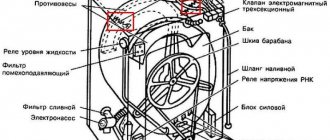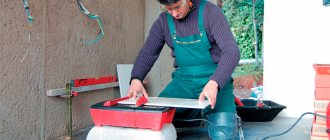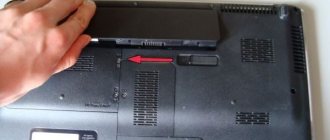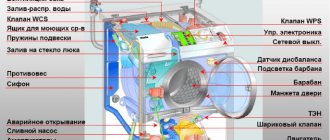Mastering a hand cutter for wood in practice
By purchasing a portable woodworking device of this type, you can independently master construction skills, relying on video and photo master classes on the Internet. These materials often contain not only the basics of working with a hand cutter, but also proprietary techniques that can expand the range of available tasks and also simplify the work.
At the initial stage of getting to know the device and functionality, it is useful to gain basic knowledge about the tool.
What a hand cutter can do
A manual milling machine is a compact power tool that has a high degree of mobility compared to a milling unit and allows you to:
- Creation of recesses and grooves.
- Drilling through and blind holes.
- Both straight and shaped processing of edge and end parts of parts.
- Sawing parts of complex shapes.
- Applying patterns and inscriptions to a wooden surface.
- High-precision copying of parts.
It is used in carpentry, as well as in construction craftsmanship and other related fields. With its help you can do a lot of woodworking:
- Production and assembly of furniture.
- Mortise of door hinges and locks.
- Artistic wood cutting.
- Wood processing during construction.
- Sawing holes and grooves.
Having a hand cutter in your home arsenal will speed up and simplify the tasks of repairing and creating wooden products, provided you follow the rules for working with power tools.
What is a router and why is it needed?
A router is a device for processing wood or metal. They process flat and shaped surfaces, and also form technological recesses - grooves, ridges, recesses for installing hinges, etc. According to the installation method, there are stationary machines (there are different types to perform different operations), and there are manual milling machines. Hand-held electric milling machines are a universal tool that allows you to carry out any operation. To change the operation, you just need to change the attachment - the cutter and/or its location on the part.
Machine tools are used mainly in mass production. In them, the cutter is installed motionless, and the workpiece moves along a certain trajectory. When working with a manual router, the situation is the opposite - the workpiece is fixed motionless and the router is moved. When processing large volumes of identical parts, it is more convenient to mount a hand router on a horizontal surface, making something similar to a milling machine.
Homemade milling machine - a horizontal plane with a hole in the middle, to which a manual router is attached from below
There are many different types of milling machines, but for the home craftsman or semi-professional use, universal ones are more suitable. They are equipped with various cutters and special devices, which allows you to perform any operation. They just require more time and skill to perform than on a specialized machine.
What can be done with a hand router:
- grooves and recesses of any shape (curly, rectangular, complex shapes);
- through and blind holes;
- process the edges and ends (can be made straight, or curly);
- cut out complex parts;
- apply inscriptions, patterns, drawings to the surface;
- copy details.
Copying parts is one of the capabilities of an electric milling machine
Similar operations are used in carpentry, in the production and assembly of furniture. A hand router can even cut into a lock or hinges on a door. Moreover, it will do this much faster and more elegantly than similar operations performed using hand tools.
Rules for working with a hand router
Working with a hand cutter on wood should be carried out using work gloves and safety glasses: this measure will protect your hands from splinters and other minor injuries, and your eyes from construction debris. Manipulations must be performed slowly, without sudden movements: otherwise the result may be disappointing due to the presence of defects (“torn” edges, grooves, etc.).
Removing and securing the knife in the clamp must be done using a screwdriver or the key included with the unit. It is important to tighten the thread firmly, but not to overdo it so as not to strip it.
The movement must be carried out evenly throughout the entire operation of the engine. Otherwise, the result will not be of good quality.
Beginners often apply too much or too little force when working with a cutter. As a result, the quality of the product suffers. You should not slow down the unit when turning the cutting element, as this can lead to overheating of the cutter and burning of the wood.
The required cutting depth is achieved by calibration - using a lifting mechanism that changes the distance between the pin and washer located next to the electric drive. A straight guide helps to achieve smooth movement of the knives during operation. Some cutters are equipped with a circular guide, which allows you to create smooth circles of large radius. Milling circles with a radius of less than 15 cm is carried out using an adjustable centering pin inserted into a provided hole in the base of the tool.
Milling of grooves is carried out using an angular stop mounted on the cutter body. The workpiece being processed is fixed in a stationary state - for safety and quality of the result. It is recommended to select grooves with a depth of more than 5 mm in several approaches. The same rule applies to any work on removing the top layer of the workpiece to any depth.
You should not start working with a router without studying the safety rules. The cutter is a source of increased danger that can cause injuries and injuries. Woodworking with a hand cutter will be safe and productive if:
- The cutter will be sharp (the need to replace the nozzle will be indicated by the uneven edge of the product and an overheating motor).
- The milled part will be fixed in a stationary state.
- The depth of wood removal will not exceed 5 mm in one approach.
- Nozzles will be replaced only after the instrument has been de-energized.
When working with a cutter, it is important to monitor the condition and “behavior” of the tool and follow the manufacturer’s recommendations contained in the instructions or on the packaging. Violation of the technological process, as well as lack of proper care of the tool, will lead to undesirable consequences. One of the most important working conditions is the correct choice of attachment for the router.
How to choose cutters
All woodwork is carried out with special cutters.
They are selected based on the type of work that will need to be carried out and the type of wood that is milled. On the Internet you can find a large number of videos that explain in detail and clearly show what a cutter looks like and how to choose it correctly. The cutter is a component of the router and consists of a shank and a working element with a cutting edge. They are distinguished by:
- cutting edge shape;
- the type of material from which they are made;
- size;
- designs.
Thus, for working on soft wood, lightweight materials for the cutter are needed. And for making an object from hard wood, preference is given to “hard” cutters.
The cutters are:
- cone-shaped;
- V-shaped;
- disk;
- Swallow's nest cutters;
- profile;
- rectangular grooved;
- moulding;
- folded;
- fillets.
In addition, cutters are divided into those that direct movement and have bearings and those that do not. Using a hand-held milling cutter without bearings, work is carried out anywhere on the workpiece.
Installation of cutter
Once the required template has been found, further woodworking should be carried out using a hand router. To do this, select and install the correct cutter . This is done in the following sequence:
- the required cutter is selected;
- its shank is inserted into the chuck so that the immersion depth is no more than 2 cm;
- Using a wrench, tighten the cartridge nut, first turning it until it clicks;
- to adjust the router to the required depth, use a movable depth stop;
- then the fine tuning knob is set to the middle position between “minus” and “plus”.
How to do the job correctly with a hand router
A large number of electrical devices for construction and repair carry out their work by rotating the shaft . A hand router makes a large number of revolutions per second. It is generally accepted that woodworking will be done cleaner by a router if there are as many revolutions as possible. In fact, this is a misconception. The object may become charred and break if the speed controller is installed incorrectly or when working with a large diameter cutter.
That is why for each type of work and material it is necessary to select and set a certain number of revolutions per second. The work will be carried out much cleaner if the ratio of the speed of movement of the cutter relative to the wood that is being cut is correctly selected.
Work with a manual router is carried out by placing it on a special table or simply holding it in your hands. Small workpieces are usually milled on a stationary table . This helps to complete the work without any defects. The router is installed on such a table with the spindle up.
In order for milling on the table to be performed without errors, it is necessary:
- Place rulers on the surface of the table to match the shape that will need to be cut;
- narrow rulers with an oval end are necessary for working with parts of variable profile and they are attached to the table surface perpendicular to the workpiece.
It should be remembered that when working with a hand router, it must be moved in the opposite direction relative to the movement of the cutter. Otherwise, the tool often breaks out of your hands and causes injury.
Compliance with safety regulations
A manual wood router necessarily requires compliance with safety precautions so as not to cause harm to health:
- if work is not carried out with the router, the cord should be unplugged from the socket;
- When working with a tool, you need to be attentive and concentrated, hold it firmly in your hands and have a stable position;
- the workpiece must be firmly fixed;
- the tool should be held very tightly, because when it comes into contact with the product, a return blow may occur that can tear the device out of your hands;
- before starting work, you need to put on clothes that will not be very loose, because excess fabric can wrap around the hand router;
- When working with a router, you should avoid inhaling fine wood dust, which is very harmful to the lungs, so you must use a respirator.
Main types of nozzles
There are many attachments for working on wood with a hand router:
- Edges. Equipped with a bearing that allows you to set the distance from the edge of the part to the knife. Used to create both curly and smooth edges on wooden parts.
- Groove (spiral, fillet, dovetail, shaped). Allows you to cut recesses and grooves.
There are both simple and stacked cutters, assembled from two or more cutting elements. Using a typesetting cutter, you can realize the required shape of the product.
In addition to the shape, attachments for hand routers differ in thickness, height, and the relative position of the knives, which allows you to select the cutting elements for any task.
The most common cutting techniques
Using milling, you can create wood products. Carved railings, furniture facades, decorative elements, all kinds of crafts and souvenirs. The capabilities of this instrument are limited only by the skill and imagination of the master himself. There are a number of basic elements that any beginner should master. Mastering the following cutting techniques will allow you to achieve complex tasks through their application and combination.
Open groove
If it is necessary to create a workpiece with a groove starting from the edge, the cutter should be positioned so that the knife protrudes beyond the edge of the wood. After this, install the cutting element and only then start the engine. After processing the edge of the product, you need to lift the knife, loosen its lock and turn off the power to the unit.
Blind grooves are created in a similar way, with the only difference being that the cutting element is installed not at the edge of the product, but at the starting point of the slot.
Deep groove
If the depth of the required groove exceeds 5 mm, it is recommended to carry out the work in several approaches, each time increasing the depth of the excavation, especially when working with hard wood. The depth of the last notch should be limited to 1.5 mm - for the smoothness of the part and the geometry of the groove.
Narrow groove
To ensure convenience and results when creating a part with a narrow groove, it is recommended to attach a flat base to the router base. This part, in tandem with guide rods installed on both sides, serves as an auxiliary plane that ensures the correct trajectory of the knife. It is important to set the location of the axes in line with the center of the cutting element. The hand cutter is driven smoothly and slowly, ensuring that the guides fit snugly to the side parts of the workpiece.
End surface
The main indicator of correct operation of a cutter with the end part of a wooden workpiece is the geometric accuracy and smoothness of the resulting edge. When processing the end, it is necessary to begin its implementation by creating a shallow cut by moving the knife in the direction of its rotation. This will ensure high quality sampling of the base material, after which all that remains is to correct the result by moving the cutting element against the direction of its rotation.
Curved edges
To create curved edges with a manual router, it is necessary to ensure the accuracy of the trajectory of the knife and use templates equipped with a stop ring. With this cutting method, a round plate with a rim, called a “ring,” moves along the template, providing a path for the cutting part of the tool. Before starting work, the thrust ring is fixed on the sole of the router. The template is attached to the workpiece, which is fixed with clamps on the working surface.
Using templates when working with a cutter allows you to produce identical parts in the required quantity.
Decorative finishing
Complex carved elements, three-dimensional patterns, paintings and inscriptions, curly cutouts - all this can be created in the milling process. As the master's practical experience increases, the complexity of the projects available to him will also increase.
Artistic milling is a popular method of processing wooden products, and knowing the basics of the process will help you cope with it.
To ensure stability of the surface being processed, it is best to use a vice. The drawing is applied to the product in advance with a simple or carpenter's pencil. After the surface is marked and firmly fixed at an angle convenient for work, the direct milling process begins.
An attachment is attached to the router, which carefully, layer by layer, removes the wood along the applied contour, which gives the image volume.
Modern architecture rarely resorts to the use of hand tools in the process of creating decorative elements. Carved trims, intricate railings, furniture with relief patterns and monograms - these products are successfully created using an electric hand router, which provides high accuracy and speed of artistic cutting.
Getting to know the router
Using a milling machine, you can work with materials such as wood and metal. With its help it is easy to create small elements, for example, grooves, ridges, recesses. They can be either stationary machines or manual, having a small configuration. To work with a router at home, it is very convenient to use the manual version.
The milling cutter is a small body equipped with a motor. There is a special holder on the body, and small adapters are inserted into it, with the help of which the device can be used with shanks of different diameters.
The milling cutter is also equipped with a platform connected to the body with rods. On its lower part there should be a special sliding base, which ensures a smooth movement of the tool while it moves along the part. Naturally, each device is equipped with a power button and a lock button.
To ensure that the milling machine does not malfunction during operation, it is necessary to periodically change the lubricant in it and keep it clean.
Safety precautions
Caution when working with a hand router is the key to the safety of the master and the results of his work. Basic safety rules:
- Use only sharp cutting elements. The degree of sharpness of the knife can be checked by carefully touching the tip of the cutter with the tip of your finger: if the skin “sticks” to the blade, the knife is sharp. Another sign of insufficient sharpness of the knife is overheating of the unit’s motor during operation and a “dirty” edge of the product.
- Check the serviceability of the power cord and plug of the unit before each time it is turned on.
- Remove dust and debris from the caliper, housing and collet nut.
- Securely fix the cutter in the collet using a wrench.
- After installing the cutting element, you should fix it in the desired position by pressing the caliper lever.
- Always use safety glasses when working with a cutter, regardless of the presence of a protective screen in the design of the unit. You can supplement your protection with a respirator.
- Before starting the electric motor, make sure that the moving part is not blocked.
- To avoid injury, first start the unit and only then insert its knife into the workpiece.
- After finishing milling, remove the knife from the part, and only then turn off the engine.
- While working, keep the rotating cutter head and the internal opening of the caliper in your field of vision.
- Before replacing the nozzle, completely de-energize the unit.
- It is important to secure the workpieces to the work surface using clamps.
- Use only clean knives. If dirt is found on the nozzle, clean it before installation.
- When using an edge cutter with a bearing, make sure that it rotates easily on the end end and does not jam or squeak.
- Use only a properly functioning unit.
A hand cutter for wood is a tool that will not take up much space, but will allow you to perform most tasks when working with wood. The unit will make minor household repairs accessible and will open up opportunities in the field of modern architecture and personal creative development. Choose a router carefully, follow the rules of its operation, and working with it will be productive and full of positive emotions.











